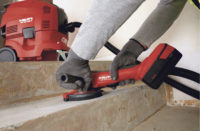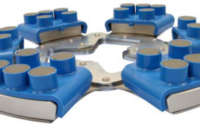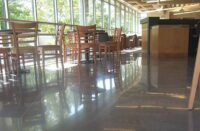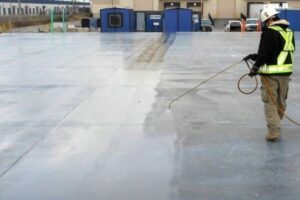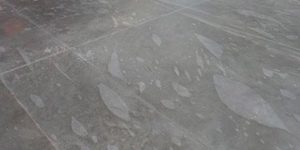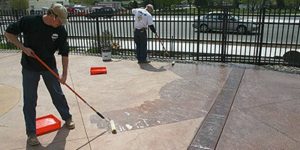This is the second of a three-part series discussing important segments of concrete placement and how decorative concrete applications can be affected by the various types of concrete installations. In the first article, we discussed the importance of correctly finishing concrete for decorative applications. We reviewed finishing tips to help produce a better working surface. This article deals with the curing of the newly placed and finished slab.

Curing is an integral part of the concrete placement process. When portland cement and water mix, they activate a process called “hydration.” Hydration is important because it is a major factor in the development of a hard, dense, abrasion-resistant surface. Curing creates a situation where the moisture vapor working its way out of the slab is trapped at or near the surface. This trapped moisture and the hydration effect it creates foster additional chemical reaction, which in turn allows that hard, dense surface to form.
Without curing, the concrete’s surface will release moisture and cool too quickly. When rapid curing occurs the concrete slab generally exhibits a type of cracking called “craze” or “map cracking.” This also can occur on hot windy days when the surface cures before the contractor even has an opportunity to apply a cure of any type.
The surface of a poorly cured slab is soft and easily abraded with regular traffic, and dusting of the surface is more common. Dusting is when the concrete starts to break apart in small pieces from the inside, releasing small pieces in the form of dust. A good cure helps eliminate this.
Generally, to get the intended strength results per specifications, interior slabs need special attention for the first seven to 10 days after placement. This time period has been proven by related testing agencies and regulatory bodies that affect concrete.

Common curing methods
There are several ways concrete is commonly cured i
n the U.S. The most common is to install a “cure and seal” to the surface. This is an impermeable membrane with a long life. Cure-and-seal’s sealer portion is regularly used on its own as the final finished floor in mechanical rooms, closets and storage areas.
The next most common method uses wax or resin-based dissipating cures. These do not have the sealer component, and they wear away or dissipate over time. Generally, the cure product turns to a powder with time and/or UV light exposure.
The third most common method is wetting the slab and placing plastic or Visqueen (trademarked polyethylene sheeting) over its surface.
The cure and seal is hard to remove because of the sealing component. This chemical membrane, which works so well to hold in moisture allowing for the concrete to cure, also does a great job of keeping chemicals integral to decorative concrete out of the slab. In order for any chemical treatments to be applied to the concrete with the expectation of penetrating into the slab, all of the cure and seal has to be removed from the surface. The sealer component of a cure and seal makes this difficult because the only two removal methods are chemically stripping or mechanically abrading the surface.Then we have true wet cures. This is generally done using continually wetted burlap to ensure the slab retains moisture. I also have seen sand berms created around the edges of slabs where the area in the middle is flooded. This is continually monitored to ensure there are no dry areas on the slab for seven days. All of these options create different results.
A dissipating cure does not have a sealer component. In time, this type of product is made to weaken and turn to powder. If necessary, a dissipating cure is much easier to remove, especially after the product starts to break down. The less invasive the removal process, the faster and cleaner a contractor can get to the desired finish.

Some specifications call for curing with Visqueen. The intent is to use the impermeable plastic barrier to trap moisture in the slab surface, creating a hydration effect. Curing with Visqueen creates a unique pattern on the concrete as the areas where the plastic touches the concrete hold more moisture and, because of hydration, are darker than the raised or bubbled areas.
Where the vapor is allowed to release, the color is lighter. Over the years, I have tried several methods to remove this pattern. Even after removing the top of the paste, the discoloration is still visible. The only way to remedy this look is to grind for exposed aggregate. As the rocks are not discolored, the aggregates break up the curing pattern so it’s no longer discernable. A similar pattern is seen when blankets are used to retain heat and moisture.
Wet cures are consistent
I have seen burlap, spread across the slab in strips, used as a wet curing agent. Sprinklers or soaker hoses keep the cloth wet for a week or so after the slab is poured. This process keeps the slab’s surface cool and moist, allowing for an even and dense cure.
Burlap works great as long as it is evenly placed with very little overlap. Overlapped areas hold more moisture so sometimes you get dark lines where the overlap occurs. If there are voids in the placement of the burlap, these will be lighter in color. Water curing a slab allows for an extremely tight finish without the need to remove any surface film. This is a great method to use for any decorative concrete purpose.
Occasionally, on smaller high-end projects I have seen sand berms created along a slab’s perimeter. Once the entire area is contained, the slab’s surface is flooded. Water evaporates and sometimes the berms allow water to leak through, but this method keeps a thin film of water on the surface of the pour for several days. This results in a tight finish with only sand to remove. No burlap disposal and easy cleanup — along with the tight, even finish — sometimes makes this option attractive.
Wet cure is the most consistent curing option, but it is also the most time-consuming one. Additional time and labor generally result in additional cost.
Recommended curing methods
The two curing methods I recommend the most for polished concrete or decorative concrete applications are the dissipating cure and the wet-burlap cure. These allow for the easiest entry into the slab with the most consistent finish and color at the end of the project.
There is a fine line between the costs associated with each curing method and the results achieved. The four methods discussed here are in order from the least costly to the most expensive and in order of the final results achieved by each.
